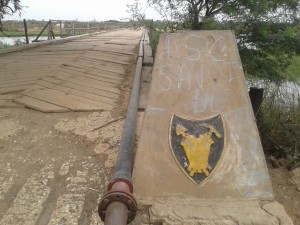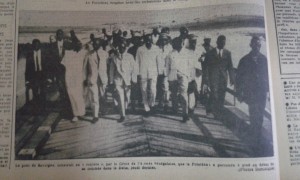Questions à… Saliou M’Baye, premier directeur Africain des Archives du Sénégal et professeur d’histoire à l’Université Cheikh Anta Diop de Dakar.
Les Archives du Sénégal ont fêté leur centenaire en 2013 : elles jouissent d’un statut particulier et comptent parmi les plus anciennes d’Afrique à tel point qu’on a pu parler de «Holy Mecca» archivistique. D’où viennent-elles et de quels fonds sont-elles exactement composées ?
Les Archives du Sénégal sont héritières du service des Archives de l’AOF, créé en juillet 1913 par le gouverneur général William Ponty pour être le réceptacle des documents produits et reçus par les services du gouvernement général dont le siège est à Dakar. L’AOF, créée en 1895, compte huit territoires, à savoir la Côte d’Ivoire, le Dahomey (actuel Bénin), la Guinée, la Haute-Volta (actuel Burkina Faso), la Mauritanie, le Niger, le Sénégal et le Soudan (actuel Mali). Il faut y ajouter le Togo de 1936 à 1946.
Les Archives du Sénégal comprennent principalement trois fonds : le fonds des Archives du Sénégal colonial (1816-1958) qui a suivi le transfert de la capitale du Sénégal de Saint-Louis à Dakar en 1958, le fonds de l’AOF (1895-1959), le fonds du Sénégal moderne (depuis 1958). Il faut y ajouter le fonds de l’éphémère Fédération du Mali qui a regroupé le Sénégal et le Soudan (1959-1960). Il s’agit de trois fonds clos et d’un fonds ouvert qui s’accroît à un rythme tel que les locaux destinés à sa conservation sont arrivés à saturation. Les Archives du Sénégal disposent également d’une Bibliothèque administrative et historique dont l’embryon est constitué par la Bibliothèque du gouvernement général de l’AOF. Le tout représente environ 13 à 14 km de métrage linéaire.
Les Archives du Sénégal comptent parmi les documents les plus anciens conservés en Afrique de l’Ouest. Elles attirent énormément de chercheurs venus du monde entier parce qu’elles ont été répertoriées et sont accessibles.
Pourquoi feu Enwere, archiviste national du Nigeria a pu, en parlant des Archives du Sénégal, les présenter comme la « Holy Mecca » des archivistes francophones d’Afrique ? C’est certainement pour plusieurs raisons. La France, contrairement à ce qu’elle a fait ailleurs, notamment en Indochine, à Madagascar ou à Brazzaville au moment des indépendances, a laissé à Dakar le fonds de l’AOF dans son intégralité. C’est l’une des « des exceptions sénégalaises », le pays en comptant bien d’autres. En outre, le fonds est riche et concerne tous les territoires constitutifs du groupe de l’AOF qui y trouvent une bonne part des sources de leur histoire. Enfin, Dakar abrite l’Ecole de Bibliothécaires, Archivistes, Documentalistes (EBAD) qui, jusqu’à récemment, a assuré la formation de la grande majorité des archivistes africains francophones qui ont été tous instruits à la pratique archivistique aux Archives du Sénégal.
Au lendemain des indépendances, que représentent les Archives nationales pour Léopold Sedar Senghor, homme de lettres et chef d’Etat ?
Le poète-président Léopold Sédar Senghor est un homme qui, en toutes choses, prônait « L’organisation et la Méthode ». C’est pourquoi, il a pu mener de pair sa vie d’intellectuel ouvert aux choses de l’esprit et celle d’un homme d’Etat averti et actif. Il porta un intérêt constant aux Archives..
En tant qu’intellectuel, il entretenait un commerce presque quotidien avec l’Archiviste national et avec les Archives. Il prenait la précaution d’interroger dès qu’une question faisait polémique et tenait largement compte de l’avis qui lui était donné. A chaque fois qu’il revenait d’un voyage officiel, il prenait soin de donner aux Archives les documents et livres qui lui avaient été offerts durant son séjour. Cependant, il n’hésitait pas chaque fois que de besoin, à les emprunter pour consultation et à les rendre en respectant scrupuleusement les conditions du prêt. Il a aidé les Archives à acquérir des documents précieux et hors de portée du budget de l’institution, dès lors qu’ils étaient susceptibles d’enrichir le fonds. Il entretenait des relations personnelles avec beaucoup de chercheurs. Il aimait les Archives et honorait les archivistes.
Le président Senghor avait l’ambition de construire un Etat moderne, convaincu qu’il était qu’aucun pays ne peut se développer durablement, s’il n’est pas fondé sur une bonne administration. En cela, les Archives constituaient une des pièces maîtresses de l’architecture administrative.
Il veillait personnellement à ce qu’elles fussent bien tenues et par du personnel de qualité. Il veillait à leur conservation et à leur valorisation particulièrement après la visite qu’il fit aux Archives en 1963, service directement rattaché à la présidence de la République. Il a personnellement défendu auprès de ses pairs africains l’impérieuse nécessité de maintenir le fonds de l’AOF dans son intégralité à Dakar. Il versait à la fin de chaque année les dossiers ayant perdu de leur valeur courante et administrative en ayant pris soin de les accompagner du bordereau de versement et de l’index des noms des personnes avec lesquelles il a entretenu de correspondances. Il savait utiliser les archives pour étayer les droits du Sénégal, notamment à l’occasion de revendications relatives au tracé des frontières. Il incarnait en cela une grande modernité.
Vous avez été le premier directeur sénégalais, formé à l’Ecole des Chartes, de 1977 à 2005 : quels ont été les principaux enjeux auxquels vous avez été confronté ?
Certes, nous étions jeune mais nous avions la chance de bénéficier du soutien à la fois de autorités et de notre personnel dévoué et engagé. Les chercheurs, d’emblée, nous ont adopté. Dès lors, il devenait aisé de dérouler la politique que nous entendions mener. Il fallait faire élever le service au rang de Direction nationale. Le président Senghor répondit favorablement à notre requête Il était nécessaire d’étoffer le personnel. Il nous fut donné la possibilité de faire recruter chaque année, l’ensemble des étudiants archivistes sénégalais diplômés de l’EBAD. Nous les gardions pendant une année aux Archives où nous les faisions travailler au classement d’un fonds, sous l’encadrement d’archivistes expérimentés avant de les mettre à la tête de services d’archives soit au sein des ministères, soit dans les régions. C’est la naissance et le développement d’une archivistique sénégalaise faite par des archivistes formés au même moule et ayant une unicité de méthodes au respect de laquelle veillait scrupuleusement une cellule d’étude et de suivi installée à la Direction des Archives à Dakar.
Il fallait créer une unité de reliure et de restauration. La France nous apporta sa coopération ; un service éducatif et de l‘iconographie orienté vers le public scolaire fut créé. Il fallait mettre la législation au goût du jour : le texte qui régissait les Archives datait de 1953 ; une loi fut adoptée en 1981.Il fallait participer à la formation des étudiants. Il nous fut demandé de dispenser des cours à l’EBAD et au Département d’Histoire de l’Université de Dakar. Nous prenions également part aux débats en publiant des livres et articles dans des revues spécialisées.
Enfin, le Sénégal se devait d’être présent au plan international. Les collègues nous ont élu en 1977 à la tête de la WARBICA, la Branche qui regroupe les archivistes de l’Afrique de l’Ouest qui venait de naître et par voie de conséquence nous devenions membre « ex officio » du Comité exécutif du Conseil International des Archives (CIA/ICA) avant d’en devenir membre élu à partir de 1984.
La coopération fut entretenue et développée avec la France qui nous apportait son concours dans tous les domaines, particulièrement dans celui de la formation en accueillant généreusement, chaque année, deux archivistes sénégalais au Stage technique International des Archives (STIA), à Paris. Nous avons organisé de nombreux séminaires et colloques avec le soutien des autorités nationales et l’appui de pays amis et d’organisations internationales.
Un grand regret : nous n’avons pas réussi à faire construire la Maison des Archives qui demeure le concentré des problèmes des Archives du Sénégal.
Cet entretien a été originellement publié sur Africa4.



